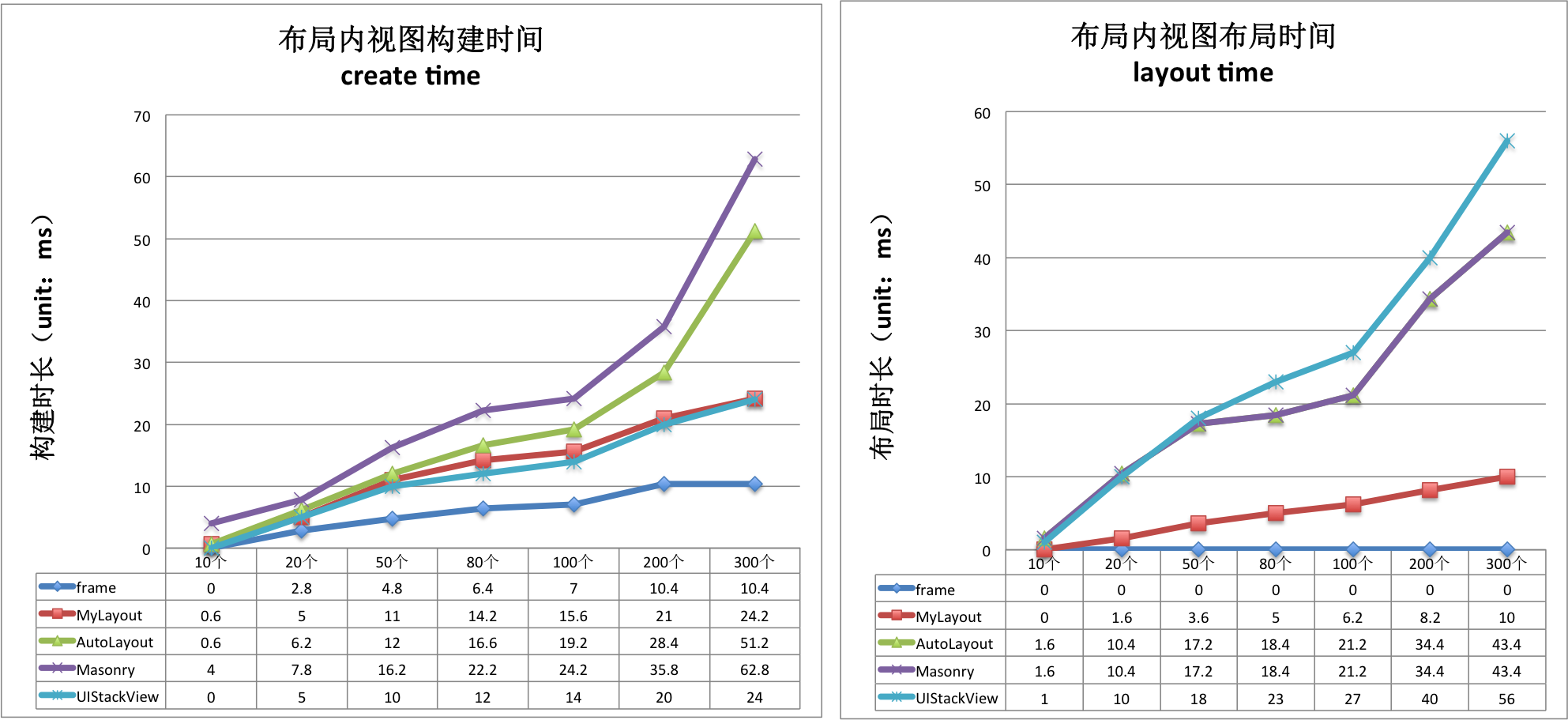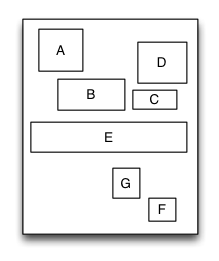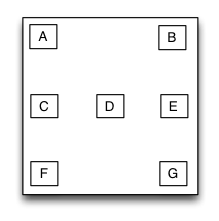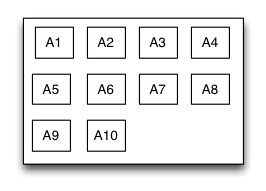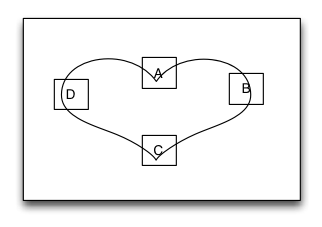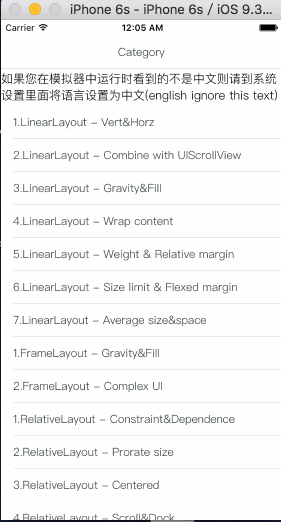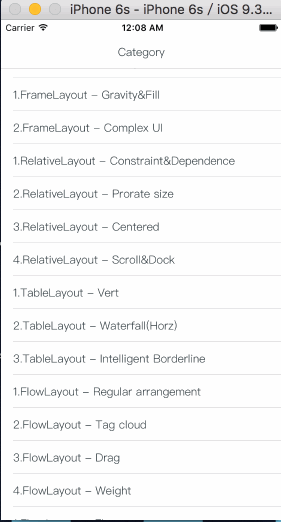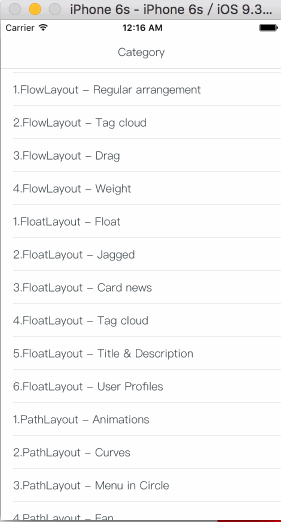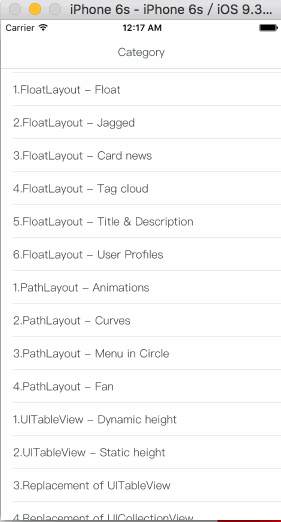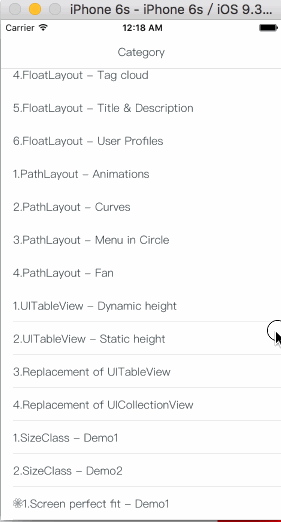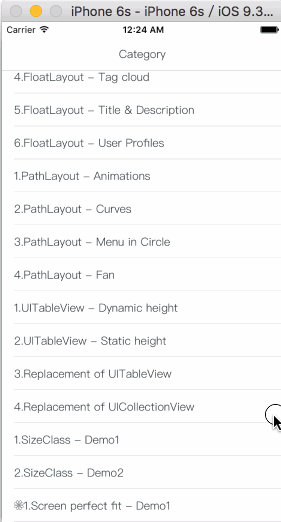TangramKit 
TangramKit 是一个简单易用的 Swift 框架,用于 iOS 视图布局。这个名字来自中国的七巧板,它提供了一些简单功能来构建各种复杂界面。它集成了包括:iOS 的 Autolayout 和 SizeClass、Android 的五个布局类、float 以及 flex-box 和 HTML/CSS 的 bootstrap 等功能。TangramKit 的 Objective-C 版本称为: MyLayout
 简体中文: 中文说明
简体中文: 中文说明
用法
- 有一个容器视图 S,宽度为 100,高度为包裹所有子视图的高度。有四个子视图 A、B、C、D 从上到下排列。
- 子视图 A 的左侧边距是 S 宽度的 20%,右侧边距是 S 宽度的 30%,高度与 A 的宽度相等。
- 子视图 B 的左侧边距是 40,宽度填充到 S 的剩余宽度,高度为 40。
- 子视图 C 的宽度填充到 S,高度为 40。
- 子视图 D 的右侧边距为 20,宽度为 S 宽度的 50%,高度为 40。
let S = TGLinearLayout(.vert)
S.tg_vspace = 10
S.tg_width.equal(100)
S.tg_height.equal(.wrap)
//you can use S.tg_size(width:100, height:.wrap) to instead
let A = UIView()
A.tg_left.equal(20%)
A.tg_right.equal(30%)
A.tg_height.equal(A.tg_width)
S.addSubview(A)
let B = UIView()
B.tg_left.equal(40)
B.tg_width.equal(.fill)
B.tg_height.equal(40)
S.addSubview(B)
let C = UIView()
C.tg_width.equal(.fill)
C.tg_height.equal(40)
S.addSubview(C)
let D = UIView()
D.tg_right.equal(20)
D.tg_width.equal(50%)
D.tg_height.equal(40)
S.addSubview(D)
TangramKit提供了重载运算符:~=、>=、<=、+=、-=、*=、/=,以便实现
let S = TGLinearLayout(.vert)
S.tg_vspace = 10
S.tg_width ~=100
S.tg_height ~=.wrap
let A = UIView()
A.tg_left ~=20%
A.tg_right ~=30%
A.tg_height ~=A.tg_width
S.addSubview(A)
let B = UIView()
B.tg_left ~=40
B.tg_width ~=.fill
B.tg_height ~=40
S.addSubview(B)
let C = UIView()
C.tg_width ~=.fill
C.tg_height ~=40
S.addSubview(C)
let D = UIView()
D.tg_right ~=20
D.tg_width ~=50%
D.tg_height ~=40
S.addSubview(D)
性能比较
| 创建时间(毫秒)/每个子视图 | 帧 | TangramKit | AutoLayout | Masonry | UIStackView |
|---|---|---|---|---|---|
| TGLinearLayout | 0.08 | 0.164 | 0.219 | 0.304 | 0.131 |
| TGFrameLayout | 0.05 | 0.149 | 0.209 | 0.273 | 0.131 |
| TGRelativeLayout | 0.079 | 0.182 | 0.116 | 0.359 | 0.131 |
| TGFlowLayout | 0.08 | 0.107 | 0.198 | 0.258 | 0.131 |
| TGFloatLayout | 0.044 | 0.148 | 0.203 | 0.250 | 0.131 |
| 布局时间(毫秒)/每个子视图 | 帧 | TangramKit | AutoLayout | Masonry | UIStackView |
|---|---|---|---|---|---|
| TGLinearLayout | 0 | 0.049 | 0.269 | 0.269 | 0.272 |
| TGFrameLayout | 0 | 0.042 | 0.243 | 0.243 | 0.272 |
| TGRelativeLayout | 0 | 0.068 | 0.274 | 0.274 | 0.272 |
| TGFlowLayout | 0 | 0.036 | 0.279 | 0.279 | 0.272 |
| TGFloatLayout | 0 | 0.055 | 0.208 | 0.208 | 0.272 |
架构
TGLayoutPos
TGLayoutPos表示视图的位置。UIView提供了六个扩展变量:tg_left、tg_top、tg_bottom、tg_right、tg_centerX、tg_centerY来设置视图的边距或与其他视图之间的空间距离。
TGLayoutSize
TGLayoutSize表示视图的大小。UIView提供了两个扩展变量:tg_width、tg_height用来设置视图的宽度和高度维度。有三个特殊的TGLayoutSize常数对象:.wrap、.fill、.average,分别表示:包裹所有子视图大小、填充到父视图的剩余大小、平均父视图的大小。
TGWeight
TGWeight用于设置相对位置和维度。TangramKit重载了%运算符,以便轻松构建TGWeight对象。例如20%等于TGWeight(20)。
TGLinearLayout
与iOS的UIStackView和Android的LinearLayout等价。
线性布局是一个单行布局视图,其子视图按添加顺序排列(自上而下或自左至右)。因此,子视图的起始大小约束由添加顺序确定。按上下顺序排列的视图称为垂直线性布局视图,而按左右顺序排列的视图则称为水平线性布局。
override func loadView() {
super.loadView()
let S = TGLinearLayout(.vert)
S.tg_width.equal(120)
S.tg_height.equal(.wrap)
S.tg_vspace = 10
let A = UIView()
A.tg_left.equal(5)
A.tg_right.equal(5)
A.tg_width.equal(100)
A.tg_height.equal(40)
S.addSubview(A)
let B = UIView()
B.tg_left.equal(20)
B.tg_width.equal(40)
B.tg_height.equal(40)
S.addSubview(B)
let C = UIView()
C.tg_right.equal(40)
C.tg_width.equal(50)
C.tg_height.equal(40)
S.addSubview(C)
let D = UIView()
D.tg_left.equal(10)
D.tg_right.equal(10)
D.tg_width.equal(100)
D.tg_height.equal(40)
S.addSubview(D)
self.view.addSubview(S)
S.backgroundColor = .red
A.backgroundColor = .green
B.backgroundColor = .blue
C.backgroundColor = .orange
D.backgroundColor = .cyan
}
TGRelativeLayout
与iOS的AutoLayout和Android的RelativeLayout等价。
相对布局是通过互相关约束来布局和定位子视图的布局视图。相对布局中的子视图不依赖于添加顺序,而是通过设置子视图的约束来布局和定位。
override func loadView() {
super.loadView()
let S = TGRelativeLayout()
S.tg_width.equal(170).and().tg_height.equal(280)
let A = UIView()
A.tg_left.equal(20).and().tg_top.equal(20)
A.tg_width.equal(40).and().tg_height.equal(A.tg_width)
S.addSubview(A)
let B = UIView()
B.tg_left.equal(A.tg_centerX).and().tg_top.equal(A.tg_bottom).offset(10)
B.tg_width.equal(60).and().tg_height.equal(A.tg_height)
S.addSubview(B)
let C = UIView()
C.tg_left.equal(B.tg_right).offset(10)
C.tg_bottom.equal(B.tg_bottom)
C.tg_width.equal(40)
C.tg_height.equal(B.tg_height, multiple:0.5)
S.addSubview(C)
let D = UIView()
D.tg_bottom.equal(C.tg_top).offset(10)
D.tg_right.equal(15)
D.tg_height.equal(A.tg_height)
D.tg_width.equal(D.tg_height)
S.addSubview(D)
let E = UIView()
E.tg_centerY.equal(0)
E.tg_centerX.equal(0)
E.tg_height.equal(40)
E.tg_width.equal(S.tg_width).add(-20)
S.addSubview(E)
//...F,G
self.view.addSubview(S)
S.backgroundColor = .red
A.backgroundColor = .green
B.backgroundColor = .blue
C.backgroundColor = .orange
D.backgroundColor = .cyan
E.backgroundColor = .magenta
}
TGFrameLayout
与Android的FrameLayout等价。
帧布局是一种布局视图,子视图可以在父视图的特定位置重叠和定位。子视图的布局位置和大小不依赖于添加顺序,并与父视图建立依赖约束。帧布局将垂直方向划分为顶部、垂直居中和底部,而水平方向则划分为左侧、水平居中和右侧。任何子视图都可在垂直方向或水平方向进行重力定位。
override func loadView() {
super.loadView()
let S = TGFrameLayout()
S.tg_width.equal(320)
S.tg_height.equal(500)
let A = UIView()
A.tg_width.equal(40)
A.tg_height.equal(40)
S.addSubview(A)
let B = UIView()
B.tg_width.equal(40)
B.tg_height.equal(40)
B.tg_right.equal(0)
S.addSubview(B)
let C = UIView()
C.tg_width.equal(40)
C.tg_height.equal(40)
C.tg_centerY.equal(0)
S.addSubview(C)
let D = UIView()
D.tg_width.equal(40)
D.tg_height.equal(40)
D.tg_centerY.equal(0)
D.tg_centerX.equal(0)
S.addSubview(D)
//..E,F,G
self.view.addSubview(S)
S.backgroundColor = .red
A.backgroundColor = .green
B.backgroundColor = .blue
C.backgroundColor = .orange
D.backgroundColor = .cyan
}
TGTableLayout
与Android的TableLayout和HTML表格等价。
表格布局是一个多行多列排列的子视图的布局视图,类似于表格。首先必须创建行视图并将其添加到表格布局中,然后添加子视图到行视图中。如果行视图按上下顺序排列,该表格视图称为垂直表格布局,其中子视图从左到右排列;如果行视图按左右顺序排列,该表格视图称为水平表格布局,其中子视图从上到下排列。
override func loadView() {
super.loadView()
let S = TGTableLayout(.vert)
S.tg_height.equal(.wrap)
S.tg_width.equal(.wrap)
S.tg_vspace = 10
S.tg_hspace = 10
S.tg_addRow(size:TGLayoutSize.wrap,colSize:TGLayoutSize.wrap)
let A = UIView()
A.tg_width.equal(50)
A.tg_height.equal(40)
S.addSubview(A)
let B = UIView()
B.tg_width.equal(100)
B.tg_height.equal(40)
S.addSubview(B)
let C = UIView()
C.tg_width.equal(30)
C.tg_height.equal(40)
S.addSubview(C)
S.tg_addRow(size:TGLayoutSize.wrap,colSize:TGLayoutSize.wrap)
let D = UIView()
D.tg_width.equal(200)
D.tg_height.equal(40)
S.addSubview(D)
//...E,F
self.view.addSubview(S)
S.backgroundColor = .red
A.backgroundColor = .green
B.backgroundColor = .blue
C.backgroundColor = .orange
D.backgroundColor = .cyan
}
TGFlowLayout
相当于CSS3中的flexbox。
流式布局是一种在多行展示的布局视图,子视图按照添加顺序依次排列,遇到排列约束时将开始新的一行并重新排列。这里提到的约束包括计数约束和大小约束。新的一行方向可以是垂直或水平,因此流式布局分为:计数约束垂直流式布局、大小约束垂直流式布局、计数约束水平流式布局、大小约束水平流式布局。流式布局常用于子视图排列规则的场景,在一定程度上可以替代UICollectionView。TGFlowLayout几乎实现了HTML/CSS中的flex-box功能。
override func loadView() {
super.loadView()
let S = TGFlowLayout(.vert,arrangedCount:4)
S.tg_height.equal(.wrap)
S.tg_width.equal(300)
S.tg_padding = UIEdgeInsetsMake(10,10,10,10)
S.tg_gravity = TGGravity.horz.fill
S.tg_space = 10
for _ in 0 ..< 10
{
let A = UIView()
A.tg_height.equal(A.tg_width)
S.addSubview(A)
A.backgroundColor = .green
}
self.view.addSubview(S)
S.backgroundColor = .red
}
TGFloatLayout
相当于CSS中的浮动。
浮动布局是一种子视图沿给定方向浮动的布局视图,当空间不足时,会自动找到最佳的重力点。浮动布局的概念借鉴自HTML/CSS的浮动定位技术,因此浮动布局可以用于实现不规则布局。根据浮动的不同方向,浮动布局可以分为左右浮动布局和上下浮动布局。
override func loadView() {
super.loadView()
let S = TGFloatLayout(.vert)
S.tg_height.equal(.wrap)
S.tg_width.equal(300)
S.tg_padding = UIEdgeInsetsMake(10,10,10,10)
S.tg_space = 10
let A = UIView()
A.tg_width.equal(80)
A.tg_height.equal(70)
S.addSubview(A)
let B = UIView()
B.tg_width.equal(150)
B.tg_height.equal(40)
S.addSubview(B)
let C = UIView()
C.tg_width.equal(70)
C.tg_height.equal(40)
S.addSubview(C)
let D = UIView()
D.tg_width.equal(100)
D.tg_height.equal(140)
S.addSubview(D)
let E = UIView()
E.tg_width.equal(150)
E.tg_height.equal(40)
E.tg_reverseFloat = true
S.addSubview(E)
let F = UIView()
F.tg_width.equal(120)
F.tg_height.equal(60)
S.addSubview(F)
self.view.addSubview(S)
S.backgroundColor = .red
A.backgroundColor = .green
B.backgroundColor = .blue
C.backgroundColor = .orange
D.backgroundColor = .black
E.backgroundColor = .magenta
F.backgroundColor = .white
}
TGPathLayout
是iOS的独特布局视图。
路径布局是一种子视图根据指定的路径曲线进行布局的视图。您必须提供一个函数方程类型、坐标和距离设置类型以创建路径曲线,从而使所有子视图在路径布局中等距排列。路径布局通常用于创建一些不规则且华丽的UI布局。
示例代码
override func loadView()
{
super.loadView()
let S = TGPathLayout()
S.tg_width.equal(320)
S.tg_height.equal(320)
S.tg_coordinateSetting.isReverse = true
S.tg_coordinateSetting.origin = CGPoint(x: 0.5, y: 0.2)
S.tg_polarEquation = { 80 * (1 + cos(CGFloat($0))) } // r = a *(1 + cos(𝛉))
for _ in 0 ..< 4
{
let A = UIView()
A.tg_size(width:40,height:40)
S.addSubview(A)
A.backgroundColor = .green
}
self.view.addSubview(S)
S.backgroundColor = .red
}
TGViewSizeClass
相当于iOS中的尺寸类。
TangramKit 为 SizeClass 提供了支持,以便适应设备的不同屏幕尺寸。您可以将 SizeClass 与上面提到的任何 6 种布局视图结合使用,以完美适应所有设备的 UI。
public func tg_fetchSizeClass(with type:TGSizeClassType, from srcType:TGSizeClassType! = nil) ->TGViewSizeClass
//all device
let rootLayout = TGLinearLayout(.vert)
rootLayout.tg_padding = UIEdgeInsetsMake(10, 10, 10, 10);
rootLayout.tg_vspace = 10
rootLayout.tg_hspace = 10
//iPhone landscape orientation.
let lsc = rootLayout.tg_fetchSizeClass(with: .comb(.any, .compact, nil), from:.default) as! TGLinearLayoutViewSizeClass
lsc.tg_orientation = .horz
演示示例
如何开始
交流
- 如需帮助,请使用 Stack Overflow 或百度。(标签'TangramKit')
- 如希望联系我,请使用 qq:156355113 或 weibo:欧阳大哥 或 email:[email protected]
- 如果您发现了一个错误,并能提供可靠的重现步骤,请打开一个问题。
- 如果您有功能请求,请打开一个问题。
- 如果您想做出贡献,请提交一个拉取请求。
安装
TangramKit 支持多种在项目中安装库的方法。
复制到您的项目中
- 将演示项目中的
TangramKit文件夹复制到您的项目中
使用 CocoaPods 安装
CocoaPods 是一个 Objective-C 的依赖管理器,它可以自动简化在项目中使用类似于 TangramKit 的第三方库的过程。您可以使用以下命令安装它
$ gem install cocoapods
要将 TangramKit 集成到您的 Xcode 项目中使用 CocoaPods,请在 Podfile 中指定它。
source 'https://github.com/CocoaPods/Specs.git'
platform :ios, '8.0'
pod 'TangramKit'
然后,运行以下命令
$ pod install
使用 Carthage
-
创建一个
Cartfile文件。github "youngsoft/TangramKit" -
运行
carthage update。 -
在您的应用程序目标“通用”设置选项卡的“链接框架和库”部分中,从磁盘上的 Carthage/Build 文件夹中将
TangramKit框架拖放到其中。 -
在您的应用程序目标“构建阶段”设置选项卡上,单击“+”图标,然后选择“新建运行脚本阶段”。创建一个运行脚本,其中指定您的 shell(例如:bin/sh),然后在 shell 下方的内容区域添加以下内容
/usr/local/bin/carthage copy-frameworks并添加以下路径到“输入文件”,例如
$(SRCROOT)/Carthage/Build/iOS/TangramKit.framework
常见问题解答
- 如果您使用 TangramKit 运行时出现 100% CPU 使用率,并且出现了约束冲突,请检查子视图的约束集。
许可证
TangramKit 采用 MIT 许可证发布。有关详细信息,请参阅 LICENSE 文件。
感谢合作伙伴
闫涛: Github 个人主页 张光凯: Github 个人主页 周杰: Github 阳光不锈: Github Hanwp: Github 博客 X: Github











